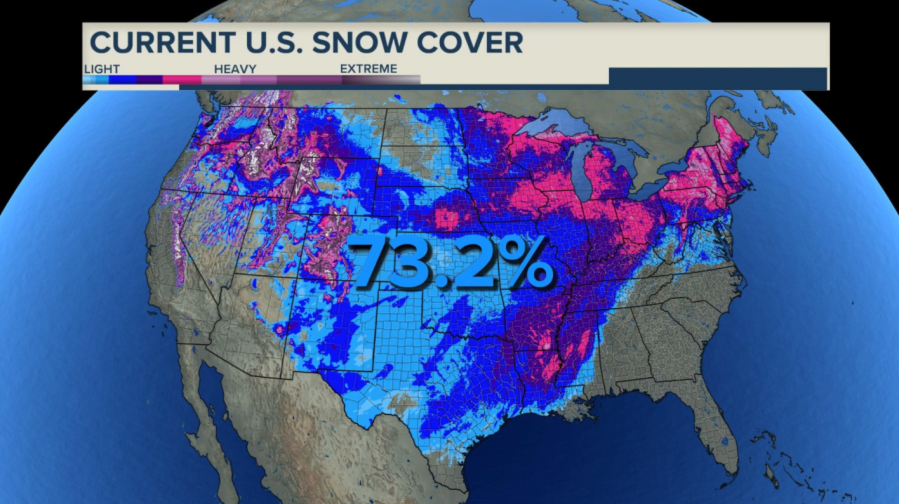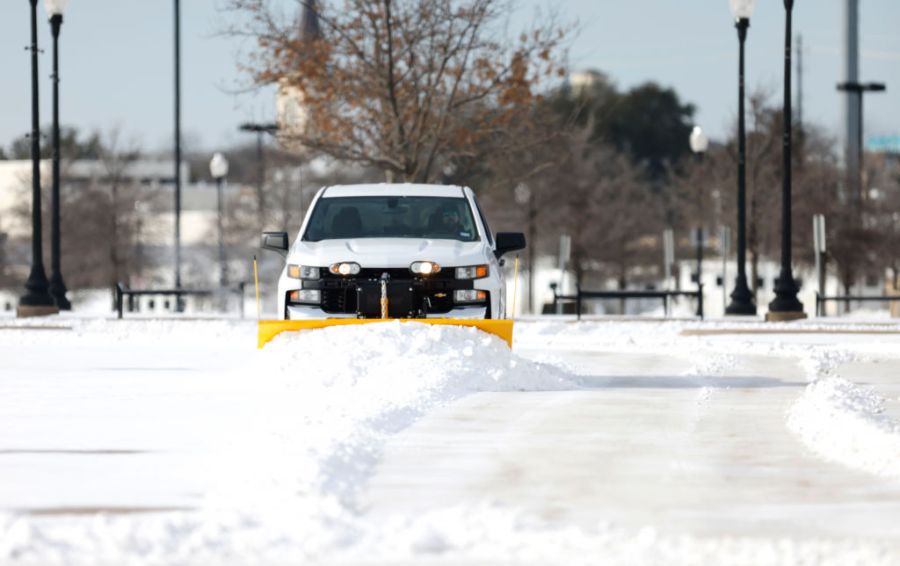20 dead in winter storm as second cross-country system moves in
Testing on staging11
HOUSTON (NewsNation Now) — A winter storm that left millions without power in record-breaking cold claimed more lives Tuesday, including four family members trying to stay warm in their Houston-area home. Three were killed in an EF-3 tornado in North Carolina, one of several spawned by cold fronts along the edge of the same weather system bringing bitter cold to much of the nation.
NewsNation meteorologist Albert Ramon says another storm will move from Texas and Oklahoma Wednesday morning, to the Mid-South in the afternoon and then into the Northeast by the late evening.
From Monday to Tuesday morning, the storm overwhelmed power grids and immobilized the Southern Plains, carrying heavy snow and freezing rain into New England and the Deep South and leaving painfully low temperatures in its wake. Windchill warnings extended from Canada into Mexico.
Satellite images Tuesday afternoon showed there was snow on the ground for about 73% of the U.S., setting an all time-record since they started keeping track back in 2003. The previous record was in January of 2011, when 70.9% of the country was covered.

At least 20 deaths have been reported in connection with the storm, with causes ranging from car crashes to carbon monoxide poisoning.
In Chicago, a foot and a half of new snow forced public schools to cancel in-person classes for Tuesday. Hours earlier, along the normally balmy Gulf of Mexico, cross-country skier Sam Fagg hit fresh powder on the beach in Galveston, Texas.
Three people died and 10 were injured when an apparent tornado tore through a golf course community and another rural area in North Carolina’s Brunswick County just before midnight Monday, destroying dozens of homes.
Residents had little notice of the dangerous weather and a tornado warning was not issued until the storm was already on the ground.
The National Weather Service was, “very surprised how rapidly this storm intensified … and at the time of night when most people are at home and in bed, it creates a very dangerous situation,” said the county’s Emergency Services Director Ed Conrow.
Sharon Benson, 63, said her roof was damaged and her garage door blown off. Windows were shattered and nearby trees were uprooted.
“The sky lit up and there was a lot of pop-pop-popping” and thunder, she said.
The National Weather Service said the storm caused an EF3 with winds estimated at 160 mph.
Utilities from Minnesota to Texas implemented rolling blackouts to ease the burden on power grids straining to meet the extreme demand for heat and electricity.
The worst U.S. power outages were in Texas, affecting more than 4 million homes and businesses. More than 250,000 people also lost power across parts of Appalachia, and another quarter million were without electricity following an ice storm in northwest Oregon, according to poweroutage.us, which tracks utility outage reports. Four million people lost power in Mexico.
Texas officials requested 60 generators from the Federal Emergency Management Agency and planned to prioritize hospitals and nursing homes. The state opened 35 shelters to more than 1,000 occupants, the agency said.
Many of the planned rolling blackouts in Texas were never brought back online. NewsNation affiliate KXAN spoke with the CEO of the Electric Reliability Council of Texas, or ERCOT, as they face criticism as millions demand answers.
“We are trying to get people’s power back on as quickly as possible,” said CEO of ERCOT Bill Magness. “But in order to do that, we need to be able to safely manage the balance of supply and demand on the grid.”
More than 500 people sought comfort at one shelter in Houston. Mayor Sylvester Turner said other warming centers had to be shut down because they lost power.
After being without power since Monday, Natalie Harrell said she, her boyfriend and four kids began sheltering at a Gallery Furniture store in Houston. Harrell said the warming center at the store, owned by Jim McIngvale, has provided people with food, water and power to charge essential electronics.
“It’s worse than a hurricane,” Harrell said. “I think we are going to be more days without light, that is what it seems like.”
Blackouts of more than an hour began around dawn Tuesday for Oklahoma City and more than a dozen other communities, stopping electric-powered space heaters, furnaces and lights just as temperatures hovered around minus 8 degrees.
Oklahoma Gas & Electric rescinded plans for further blackouts but urged users to set thermostats at 68 degrees, avoid using major electric appliances and turn off lights or appliances they are not using.
Nebraska’s blackouts came amid some of the coldest weather on record: In Omaha, the temperature bottomed out at 23 degrees below zero overnight, the coldest in 25 years.
The Southwest Power Pool, a group of utilities covering 14 states, said the blackouts were “a last resort to preserve the reliability of the electric system as a whole.”
The weather also threatened to affect the nation’s COVID-19 vaccination efforts as President Joe Biden’s administration said delays in vaccine shipments and deliveries are likely.
The outages forced a Texas county to scramble to administer more than 8,000 doses of Moderna’s coronavirus vaccine after a public health facility lost power early Monday and its backup generator also failed, said Rafael Lemaitre, a spokesman for Harris County Judge Lina Hidalgo.
County officials distributed the doses at three hospitals, Rice University and the county jail because those places had large groups of people available where they would not have to drive and with appropriate medical personnel on hand.
“It feels amazing. I’m very grateful,” said Harry Golen, a college sophomore who waited for nearly four hours with his friends, much of it in the cold. He was among the last people to get the shots, which otherwise would not have reached students until March or April.
Texas officials said more than 400,000 additional doses due now will not arrive until at least Wednesday because of the storm.

Authorities in multiple states reported deaths in crashes on icy roads, including two people whose vehicle slid off a road and overturned in a waterway in Kentucky on Sunday, state police said.
In Texas, three young children and their grandmother died in the Houston-area fire, which likely began while they were using a fireplace to keep warm during a power outage, a fire official said.
At least 13 children were treated for carbon monoxide poisoning at Cook Children’s Medical Center in Fort Worth, the hospital said in a social media post, which warned that families were “going to extreme measures to warm their homes” with propane or diesel-burning engines and generators as well as gas ovens and stovetops. One parent died of the toxic fumes, pediatrician Phillip Scott told Fort Worth television station KTVT.
Other Texas deaths included a woman and a girl who died from suspected carbon monoxide poisoning in Houston at a home without electricity from a car left running in an attached garage, and two men found along Houston-area roadways who likely died in subfreezing temperatures, law enforcement officials said.
In west Tennessee, a 10-year-old boy died after falling into an ice-covered pond on Sunday during a winter storm, fire officials said. His 6-year-old sister was injured and rushed to the hospital in critical condition where she remained as of Monday morning.
Several cities had record lows: In Minnesota, the Hibbing/Chisholm weather station registered minus 38 degrees Fahrenheit. Sioux Falls, South Dakota, dropped to minus 26 Fahrenheit.

Air travel was also affected. By Tuesday midday, more than 2,700 U.S. flights had been canceled, led by more than 800 at Dallas Fort Worth International Airport and more than 700 at Bush Intercontinental in Houston.
Most government offices and schools were closed for Presidents Day, and authorities pleaded with residents to stay home Tuesday, too. About 100 school systems closed, delayed opening or switched to remote classes on Tuesday in Alabama, where forecasters said conditions might not improve until temperatures rise above freezing Wednesday afternoon.
NewsNation affiliates from around the U.S. contributed to this report. Primary reporting by The Associated Press’ Bryan Anderson and AP staff nationwide.
